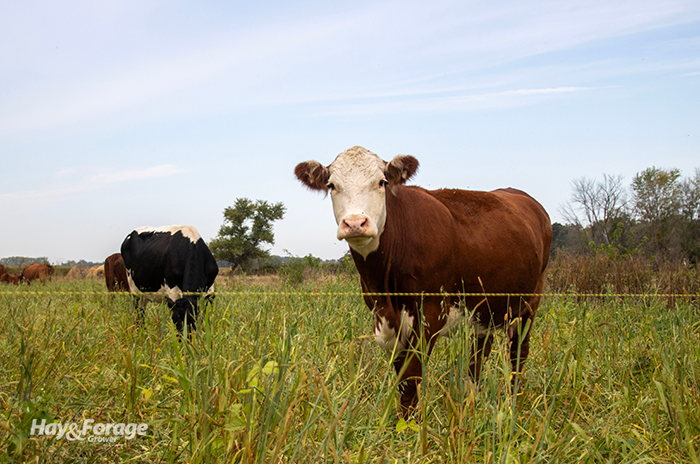
All entrepreneurs want their businesses to be profitable, and the greater the profit margin, the better. Grazing businesses are no exception, but factors like land area, carrying capacity, and feed costs can throw a balance sheet off-kilter.
At a pasture walk near Burlington, Wis., earlier this month, Jim Gerrish offered advice for those starting a new grazing business. Whether you are a beginning farmer or someone who is interested in adding an enterprise to your current operation, he said the key to a profitable system is keeping it simple.
“There are only four needed ingredients for making meat, milk, and fiber: carbon dioxide, solar energy, water, and soil. Everything else that we do adds costs,” Gerrish asserted. “The more iron and oil you put between these basic resources, the less likely you are to be profitable.”
Gerrish’s next tip for simplifying farm profitability was to build your salary into the business plan first. This number will vary based on your lifestyle, financial, resource, and production goals.
Consider your lifestyle. Do you have a spouse and/or children? Are you independent and retired? Do you like to plan trips and take vacations throughout the year? Are you more conservative with your spending? These are questions Gerrish asked each member of the audience to consider about their lifestyle to estimate an appropriate salary to support it.
If you have long-term lifestyle goals, such as owning more land or moving to a different location, set aside a salary from your budget that can help you achieve them. Gerrish suggested creating a rough timeline for future goals with further help define your current pay.
Focus on finances. Reducing costs and boosting income are two sides of the same coin when it comes to farm profitability. Gerrish said the greatest limitation to graziers is often the cost of owning unnecessary equipment, followed by maintaining underutilized facilities and footing overhead expenses.
“Most people in the cow-calf business are overcapitalized in equipment; they have way more equipment than their cows will ever pay for,” Gerrish said. “It’s critical that you know what these costs are because profitability is driven much more by the cost of the operation than the revenue of the operation.”
With that said, the three most effective ways to boost income are to increase animal units, improve the value of individual animal units, and diversifying the operation with other enterprises, such as by raising sheep, goats, or pasture-raised swine or poultry.
Reclaim your resources. Forages are the primary resource in grazing systems. Therefore, managing forage production by grazing in a way that stimulates plant growth, benefits soil health, and provides adequate nutrition for livestock is crucial to farm profitability.
One way to improve forage utilization is to rotationally graze cattle. There are several ways to do this, including management-intensive grazing. No matter the strategy, though, most techniques are rooted in the same principles soil health and forage growth that promote a longer grazing season and minimize hay feeding.
“It almost always costs more to feed an animal stored feed than it does to let them graze,” Gerrish stated. He referred to advice from grazing expert Burke Teichert who recommended limiting hay feeding to 15% of the year. “That is about 52 days,” Gerrish added. “If you are feeding hay more days than that, you’re going to have a hard time making money.”
Put the pieces together. The final point to ponder is how well a system works as a whole to accomplish the final product. Gerrish noted one challenge with a multi-generational operation may be that producers follow a similar framework year after year when there could be potential for better profits with a different approach. Starting a grazing system from scratch, on the other hand, offers the opportunity to explore new ways of establishing a profitable business model.

